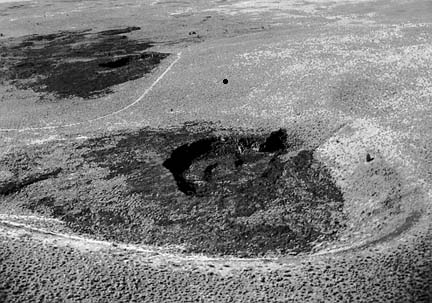
Diamond Craters is a monogenetic volcanic field in southeast Oregon. The volcanoes are all Quaternary in age. Lava flows and tephra from the volcanoes cover an area of about 23 square miles (60 square km). This photo shows Keyhole Crater. Special thanks to Rosemary Kenney.

Diamond Craters includes numerous features associated with basaltic volcanism including cones, explosion and collapse craters, fissures, and grabens. This photo shows the cone and pit crater of Lava Pit.

Little Red Cone is a cinder cone in the Diamond Craters volcanic field. Diamond Craters is about 60 miles (100 km) south-southeast of Burns, Oregon.
All photos courtesy of the Oregon Department of Geology and Mineral Industries.
Sources of Information:
Peterson, N.V., and Groh, E.A., 1964, Diamond Craters, Oregon: Ore Bin (Oregon Geology), v. 39, p. 125-140.
Russell, J.K., and Nicholls, J., 1987, Early crystallization history of alkali olivine basalts, Diamond Craters, Oregon: Geochim. Cosmochim. Acta, v. 51, p. 143-154.
Simkin, T., and Siebert, L., 1994, Volcanoes of the World: Geoscience Press, Tucson, Arizona, 349 p.
Wood, C.A., and Kienle, J., 1993, Volcanoes of North America: Cambridge University Press, New York, 354 p.